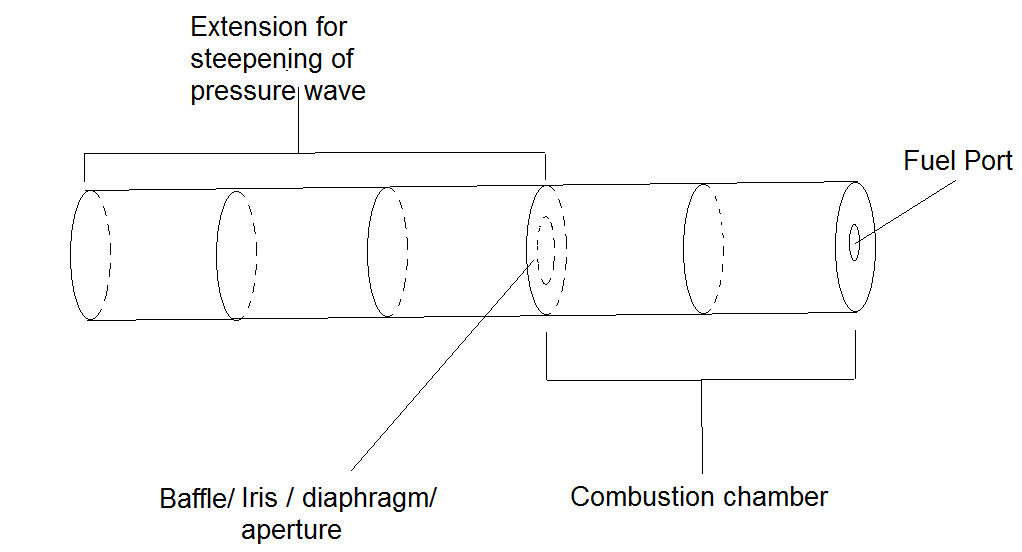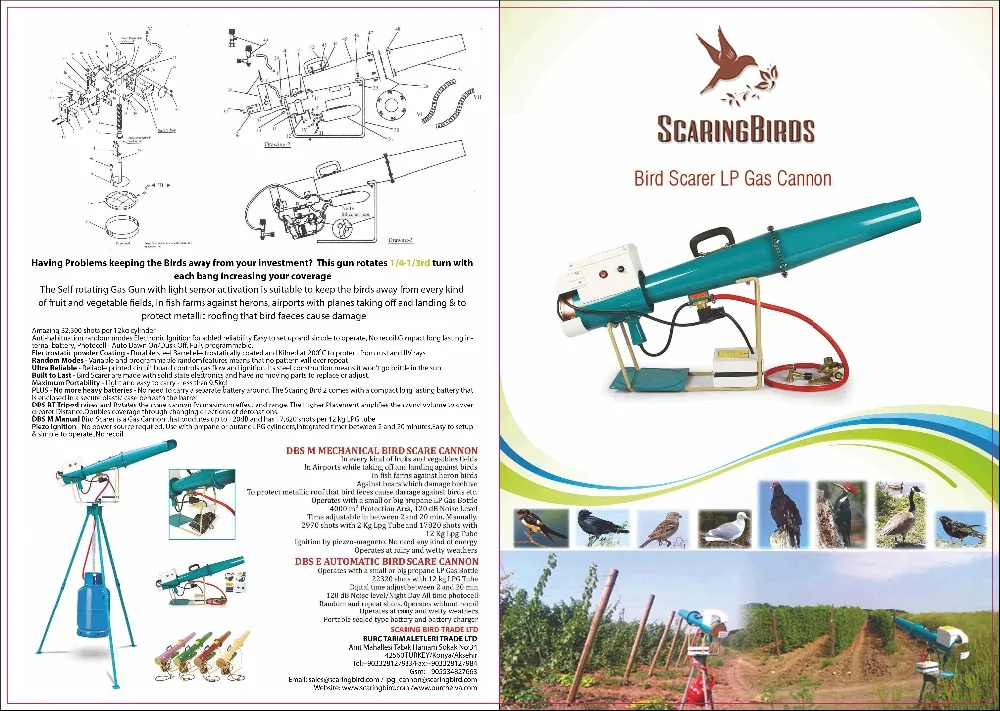When last we left our story, I was puzzled by bird cannons, a.k.a. bird scarers or bird scaring cannons. I was clueless as to the basic function, and I was having a lot of trouble finding info on the web. I had basically settled on using some kind of popper valve, resembling a sort of one-shot two-cycle engine or perhaps a one-shot pulse jet. Then, at last, I found this Instructable:

Perhaps a little underwhelming to some, but I was grateful for this game-changer. This Instructable was similar to another that was a simple tennis ball mortar. The photo clearly shows several tin (steel) food cans taped together. This is misleading; the device is actually-- well, no, it's several tin cans taped together. But it is NOT a simple pipe. Improving considerably on the illustration in the Instructable, I drew a diagram with a little more detail:

Why does the photograph show four cans and my illustration five? I have no idea. The description in the text makes it clear that five is the minimum number of cans. That bit about the "steepening" will be explained below.
Propane-air mixture is inserted into the combustion chamber through the hole on the right, then ignited soon after. The assemblage of cans then makes a sound like a shotgun blast. According to the Instructable, one can make it even louder by adding additional "baffles", which I have labeled "Baffle/ Iris/ diaphragm/ aperture". lasermaster3531 states:
"In my design, I alternate fully removing the bottom of one can and leaving half of the bottom on the next one, until I get to the muzzle end which has three can-lengths unobstructed. The can bottoms serve an important role, don't just tape cans together and think it will work if it's essentially a simple pipe. The "baffles" (can bottoms) cause the speed of the flame to increase every time it has to pass through a baffle, which greatly improves the loudness and pitch of the noise made. A simple tube closed at one end will usually just make a "whoosh" or "thump" sound, but a properly fueled and constructed noisemaker sounds like a shotgun blast."
This was precisely the information I was hoping for. But what was so critical about baffles for making noise? Drawing on my limited knowledge of fluid dynamics, it seemed like the baffle acted as a nozzle, accelerating flowing gases while reducing the pressure. Did this create a shock wave? I couldn't wrap my brain around it.
Then I found this paper, "A Gasdynamic-Acoustic Model of a Bird Scare Gun", by S.W. Rienstra, which helped immensely. (Warning-- link downloads a .pdf file.) While the Instructable gave an immediately practical way to get a SCPOB, the paper explained the theory. It did not mesh with the baffle/ nozzle idea. Apparently the paper was part of a series that attempted to mathematically model a number of industrial devices.
The paper is a tad frustrating in that bird cannons are hard to model. There are many approximations and assumptions, and the questions laid out in the introduction are not able to be adequately answered. Nevertheless, the paper was invaluable to me. Here is the excellent overview of how a bird cannon works:
"The mechanism is simple. A carefully-controlled mixture of air and propane or butane gas (stoichiometric1 mixture, or a little bit richer than that) is periodically (every 5 or 10 minutes) blown into a semi-open pot, which is the combustion chamber. This pot is connected via a small diaphragm or iris (a small hole in the wall of the combustion pot) to an exhaust pipe. After ignition, the gas burns quickly (but without detonation, i.e. with a subsonically moving flame front) so that pressure and temperature increase quickly. This high pressure drives the gas out of the pot via a hot jet, which issues from the diaphragm into the pipe. Acting like a piston, this jet creates a pressure wave in the cold exhaust pipe. Part of the wave reflects at the exit, and part radiates, nearly spherically, away into the open air.
1Stoichiometric mixture = just enough of each component for a complete chemical reaction."
So the "baffle" is critical to operation, but the explanation is somewhat different. Reinstra calls this hole the "diaphragm" or "iris". I found this a trifle annoying, as these words seem to denote the material around the hole, not the hole itself. The hole seems to be the critical bit, so I stubbornly call it an "aperture". Of course, you can't have a hole without the stuff around it, so I guess it's a matter of semantics.
Here is an illustration in the paper:

(1) is the "pot" where combustion happens, with the diaphragm (aperture!) on the right side. (2) is the "exhaust pipe". (j) is the "hot jet" of burned/burning gases that rams into the column of air in the cold pipe. L is the length of the "exhaust pipe", a.k.a "cold pipe". x is how far along you are on the pipe, and x=0 is where the "hot jet" hits the cold air.
This immediately helps with these diagrams of bird cannons. The plate with a hole in it is-- a plate with a hole in it. (M6 in the second picture, some illegible number in the first.) Before, I couldn't tell if it was part of some kind of valve assembly or if it was even important in sound generation. Now I understand it is both simple and critical.


The paper agrees with the Instructable that the aperture is critical. According to Reinstra:
"The size of the diaphragm is also known to be very critical for the loudness of the sound. On one hand, too large a hole would allow the
gas to be blown away too quickly so that not all the gas reacts, and the pressure wave remains too flat. On the other hand, with too small
a hole the mass flux of the jet will remain too small, and hence the created pressure wave will be too small. Somewhere, there is obviously an optimum."
Sadly, the paper had no mathematical tricks for finding an optimum diaphragm/ aperture diameter. Reinstra states: "At present, the design of a bird scare gun is mainly done by trial and error using the skills of the experienced craftsmen." The Instructable gives this parameter short shrift, and barely mentions that the hole should be half the diameter of the can. This might be bad news for me in my search to literally get the most bang for my buck.
There is no mention in the paper of using multiple baffles/ irises/ diaphragms/ apertures. Do more holes improve performance? The Instructable insists it does, as does the tennis-ball cannon Instructable. I could find no mention of baffles on Google when it came to firearm or artillery design, with the exception of silencers. So I have my doubts. On the other hand, guns of all types and the bird cannons often are tapered, so that might help.
Notice that bird cannons look like cannons. If the aperture alone would do the trick, why have all that steel downstream? The paper explains further:
"An interesting detail in the design gave, without any further analysis, already insight in the gasdynamic behaviour. In order to vary the noise that is produced, the length of the exhaust pipe is made variable. The pipe consists of two shorter pipes, one of which slides inside the other, like a telescope. It appears that the gun produces a louder bang when the pipe is longer. This hints, of course, at a possible relation to nonlinear wave steepening. A pressure wave of high enough amplitude steepens while propagating onto the pipe exit. Indeed, from fairly elementary acoustics it is known, that (at least for low frequency linear perturbations) the radiated part is proportional to the derivative of the pipe wave. Therefore, a longer pipe, leading to more advanced steepening, may be expected to produce more noise. So the effect of steepening is not only to intensify the higher frequencies -the pitch- of the radiated pulse but also to increase its amplitude." [emphasis mine]
This agrees well with the Instructable, which states you won't get much of a bang unless you put at least three cans on the end of the combustion chamber.
I made the (single baffle) device in the Instructable and tested it with zero, one, two, and three cans on the output. See the video below!
Indeed, three cans gives a bigger bang. (Yes, it's a little foopy, but the mic didn't do it justice.) It also gave me the chance to realize how lousy my electrical ignition is.
Now that I have a practical means of making a propane bang, I am also faced with some troubling facts. The aperture diameter and pipe length both affect pitch and volume, and the math is not straightforward. Having the pitch and volume too closely related is far from ideal for an instrument. My instrument is designed to have only a single volume-- loud-- ,but all the notes should have roughly the same perceived loudness. Am I doomed to create dozens of prototypes for trial and error? Or should I run comprehensive FDTD gas dynamic simulations that require graphics cards I can't afford and coding that could take a year?
I suppose my next step will be to see if I can use the simplified model in the paper (just the pipe) while tweaking the aperture experimentally. If worse comes to worst, perhaps I can make a loud propane pistol or a row of guns that fire into the mouths of resonating pipes, like Explodophone 1.0.
 bryan.lowder
bryan.lowder
Discussions
Become a Hackaday.io Member
Create an account to leave a comment. Already have an account? Log In.